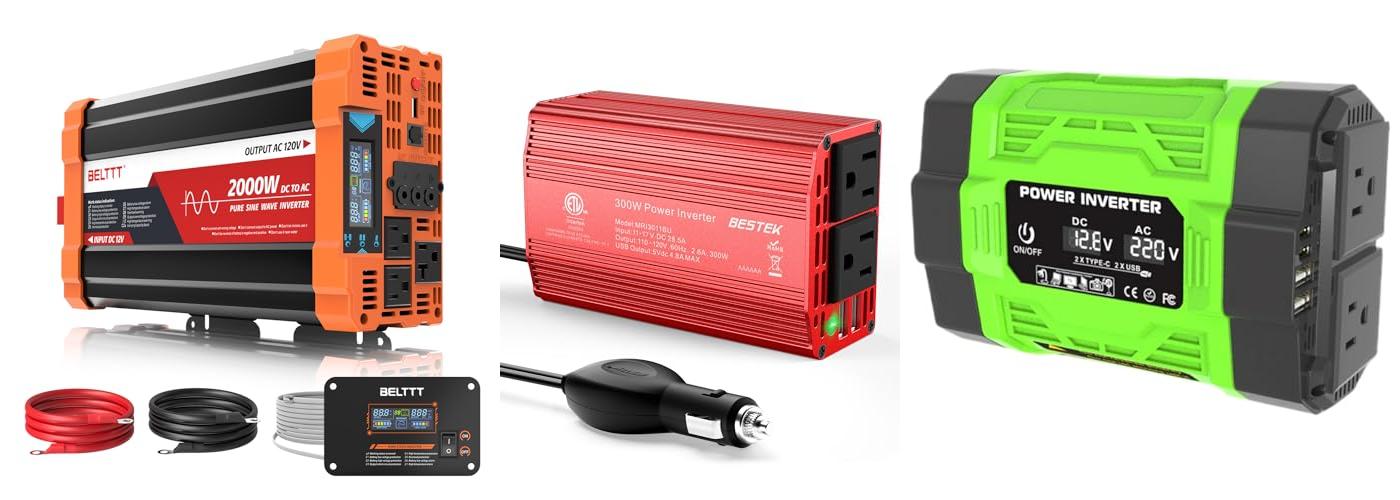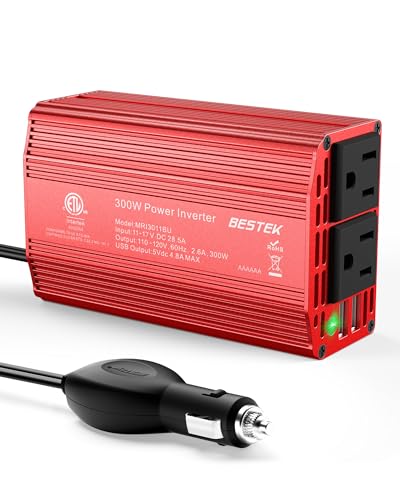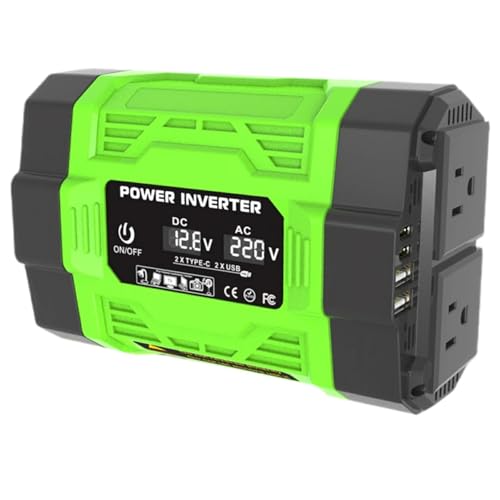Imagine this: your favorite campsite is miles from any power outlet, but you desperately need to charge your phone or run your small fan. Or maybe a storm knocks out the electricity at home, and you want to keep essential devices working. How do you bridge the gap between your car battery or solar panels and the everyday appliances you rely on? That’s where a power inverter comes in, transforming the direct current (DC) from a battery into the alternating current (AC) your devices use.
But finding the *perfect* power inverter can feel like navigating a maze. There are so many types, wattages, and features! You might wonder, “Will this inverter be strong enough for my needs?” or “Is this the best value for my money?” It’s easy to feel overwhelmed and worried about making the wrong choice, potentially ending up with an inverter that doesn’t work or breaks down quickly.
This post is here to clear the confusion. We’ll break down what makes a good power inverter and guide you through the most important things to consider. By the end, you’ll feel much more confident about choosing an inverter that fits your adventures, your home, and your budget. Let’s dive in and discover the power of choosing wisely!
Our Top 5 Power Inverter Recommendations at a Glance
Top 5 Power Inverter Detailed Reviews
1. BELTTT 2000W Pure Sine Wave Inverter
Rating: 8.8/10
The BELTTT 2000W Pure Sine Wave Inverter is a powerful tool for anyone needing electricity on the go. It converts your car’s 12V power into 110V-120V AC power, just like what you get from a wall outlet at home. This makes it great for RVs, trucks, camping trips, or any outdoor adventure where you need to power your devices. It can handle everything from sensitive electronics like TVs and stereos to larger appliances, thanks to its strong surge power.
What We Like:
- It provides a strong 2000W of continuous power and can handle up to 4000W for starting devices.
- The pure sine wave output is safe for all your electronics, extending their life and preventing damage.
- A bright LCD screen shows you important information like voltage and battery status, helping you monitor everything.
- It comes with multiple ways to connect your devices, including two AC outlets, a 20A socket, a USB port, and a hardwire option.
- A handy remote controller with a long cable lets you operate the inverter from a distance.
- It has many safety features to protect both the inverter and your devices from problems like overloads or short circuits.
What Could Be Improved:
- While efficient, the unit’s no-load losses could be further reduced for even better energy savings.
- The adjustment range for the output voltage and screen is noted as “small,” which might limit fine-tuning for some users.
This BELTTT inverter offers reliable power for a variety of needs. It’s a solid choice for powering your adventures and keeping your devices running smoothly.
2. BESTEK Power Inverter DC 12V to AC 110V – 300W Car Plug Adapter Outlet with 4.8A Dual USB Fast Charging Port – Car Charger Cigarette Lighter Adapter for Phone
Rating: 9.2/10
Hit the road with power! The BESTEK Power Inverter DC 12V to AC 110V – 300W Car Plug Adapter is your ultimate travel companion. This handy device transforms your car’s 12V DC power into 110V AC power, perfect for charging all your gadgets on the go. It’s like having a mini power station right in your car, making long trips and adventures much more enjoyable.
What We Like:
- It’s super compact, about the size of an iPhone, making it easy to pack.
- You get two AC outlets for bigger items like laptops and two USB ports for your phone and other devices.
- The dual USB ports offer fast charging at 4.8A each, so your devices power up quickly.
- It’s built tough with a durable aluminum housing that can handle bumps and drops.
- Safety is a priority with built-in protection against overheating, over/under voltage, and short circuits.
- The smart cooling fan is quiet and only speeds up when needed.
- BESTEK offers a fantastic 5-year warranty and 24/7 customer support.
- It’s compatible with a wider voltage range, including newer cars like Tesla.
What Could Be Improved:
- The 300W continuous power might not be enough for very high-power appliances.
This BESTEK power inverter is a must-have for anyone who spends time on the road. It keeps your devices charged and your journey powered up.
3. RFYD AUTO Car Power Inverter
Rating: 8.6/10
The RFYD AUTO Car Power Inverter is a handy gadget for anyone who needs to power their electronics on the go. This device turns your car’s 12V DC power into 110V AC, just like your home outlets. It’s small and light, making it easy to keep in your car or take with you on trips.
What We Like:
- It can charge many devices at once because it has two USB ports and a Type-C port.
- Its small size (6.5 x 4.3 inches) and light weight (1.32 pounds) make it super portable.
- The LCD screen shows you the power levels, so you know what’s happening.
- It has regular AC outlets, plus the USB and Type-C ports for all your gadgets.
- A built-in fan keeps it cool, and the strong case protects it.
What Could Be Improved:
- The power output might not be enough for very large appliances.
- The fan noise could be noticeable in a quiet car.
This power inverter offers a practical solution for keeping your devices charged wherever you are. It’s a solid choice for travelers and anyone who needs power away from home.
4. TWING Car 1000w Inverter
Rating: 8.5/10
The TWING Car 1000w Inverter is a handy gadget for anyone who needs power on the go. It turns your car’s 12V battery into a standard 110V outlet, just like you have at home. This means you can power up laptops, tablets, and even small appliances when you’re camping, tailgating, or just stuck in an emergency. It comes with two AC outlets and fast-charging USB ports, including a Type-C port, making it super versatile.
What We Like:
- It gives you two 110V AC outlets for bigger electronics.
- It has fast-charging USB ports, including a QC 3.0 and a 30W PD Type-C.
- The digital display shows you important information.
- It has safety features like overload and short circuit protection.
- It’s great for emergencies, camping, and outdoor adventures.
- It comes with both cigarette lighter and clamp wire options for connection.
- It has important certifications like CE and FCC.
What Could Be Improved:
- It provides 750 Watts of continuous power, not the full 1000 Watts for all devices.
- The cigarette lighter adapter is limited to 150 Watts surge capacity.
This inverter is a really useful tool for powering your devices anywhere. It offers a good balance of power and safety for your adventures.
5. Cantonape 3000W Power Inverter 12V to 110V/120V DC to AC with LCD Display
Rating: 8.8/10
Power up your adventures and everyday needs with the Cantonape 3000W Power Inverter! This robust device transforms your 12V DC power into a reliable 110V/120V AC supply, perfect for your car, truck, boat, RV, or even your solar system. It’s designed to handle a variety of appliances, making it a versatile companion for any situation.
What We Like:
- It’s incredibly powerful, delivering 3000 Watts continuously and 6000 Watts for surges, so you can run multiple devices at once.
- The intelligent LCD display shows you everything you need to know, like voltage, battery level, and load, and even warns you of any problems.
- You get a handy remote control to easily turn the inverter on and off from a distance.
- It has multiple safety features, including 6 replaceable fuses and protection against overloads, short circuits, and overheating, keeping your devices safe.
- The durable aluminum body and built-in cooling fan help it last a long time, even in tough conditions.
- It has four AC outlets and four USB ports, so you can charge all your gadgets.
- High conversion efficiency means less wasted power.
What Could Be Improved:
- The remote control needs a 12V 23A battery, which isn’t included.
- The protection against reverse polarity is mentioned, but it’s important to ensure correct connections.
This Cantonape power inverter is a fantastic tool for anyone needing portable power. It offers great performance and safety features for a wide range of applications.
Choosing the Right Power Inverter: Your Guide to Portable Electricity
Power inverters are amazing gadgets. They let you use your car’s battery or a deep-cycle battery to power regular household electronics. Think of it like having a small power plant with you wherever you go! This guide will help you pick the perfect one.
Key Features to Look For
When you shop for a power inverter, keep these important features in mind:
Continuous Power Output
This is how much power the inverter can supply steadily. Your devices have wattage ratings; make sure the inverter’s continuous power is higher than the total wattage of the things you want to plug in at once.
Peak Power (Surge Power)
Some devices, like refrigerators or power tools, need a big burst of power when they first start. Peak power is that extra boost. The inverter needs to handle this surge.
Waveform Type
- Modified Sine Wave: These are cheaper. They work fine for simple electronics like phone chargers or lights. However, some sensitive devices, like medical equipment or some laptops, might not work well or could even get damaged.
- Pure Sine Wave: These are more expensive but much better. They produce clean power that is just like what comes from your wall outlet. This is the best choice for almost all electronics, especially sensitive ones.
Input Voltage
Most portable inverters use 12V (from a car battery). You can also find 24V or 48V models for larger setups. Make sure it matches your battery system.
Output Voltage and Frequency
In most countries, this will be 110-120V at 60Hz or 220-240V at 50Hz. Make sure it matches your country’s standard.
Safety Features
Look for built-in protections. These include:
* Overload protection (stops working if you plug in too much)
* Over-voltage protection (protects against too much battery power)
* Low-voltage shutdown (protects your battery from draining too much)
* Short-circuit protection (prevents damage from faulty connections)
* Over-temperature protection (shuts down if it gets too hot)
Important Materials and Build Quality
The way an inverter is built matters a lot.
Cooling Systems
Good inverters have fans. These fans keep the inverter from overheating, especially when it’s working hard. Some might have heatsinks to help with cooling. A well-cooled inverter lasts longer.
- Aluminum Casing: Many inverters use aluminum. It’s light and helps with heat dissipation. It also makes the inverter durable.
Connectors
- Battery Cables: Thick, high-quality battery cables are important. They carry the power from your battery to the inverter. Thin or cheap cables can cause power loss or even melt.
- AC Outlets: Make sure the outlets are sturdy and well-connected.
Factors That Improve or Reduce Quality
What makes one inverter better than another?
Efficiency Rating
This tells you how much of the battery power is turned into usable AC power. Higher efficiency means less power is wasted as heat. Look for inverters with 85% efficiency or higher.
-
Brand Reputation: Well-known brands often use better parts and have stricter quality control. This usually means a more reliable product.
-
Fan Noise: Some inverters have noisy fans. If you plan to use it in a quiet place, this might be a factor. Higher-end models often have quieter fans.
-
Build Materials: Cheap plastic parts can break easily. Solid metal casings and good internal components indicate better quality.
User Experience and Use Cases
How will you use your inverter? Think about where and what you’ll power.
Camping and Outdoors
An inverter lets you run small appliances like coffee makers, fans, or charge your electronics while camping.
RV and Van Life
This is a popular use. You can power laptops, small TVs, or even a microwave when you’re on the road.
-
Emergency Power: During power outages, an inverter can keep essential devices running, like lights, a phone charger, or a medical device.
-
Job Sites: If you work on construction sites or in places without power, an inverter can run power tools or charge batteries.
-
Boating and Marine Use: Keep your electronics powered up while out on the water.
Choosing the Right Size
Always calculate the total wattage of the devices you want to run. It’s better to get an inverter that’s a bit bigger than you think you need. This gives you some wiggle room and prevents the inverter from being constantly overloaded.
Frequently Asked Questions (FAQ)
Q: What is the difference between continuous power and peak power?
A: Continuous power is the amount of power the inverter can supply all the time. Peak power is the extra boost it can give for a short time when a device starts up.
Q: Can I use a modified sine wave inverter for my laptop?
A: It’s risky. While some laptops might work, others can be damaged. A pure sine wave inverter is much safer for laptops and other sensitive electronics.
Q: How do I know what size inverter I need?
A: Add up the wattage of all the devices you plan to run at the same time. Then, add a little extra for safety. For devices that start with a surge, check their peak wattage.
Q: Can I plug the inverter directly into my car’s cigarette lighter?
A: Some small inverters can. However, most larger inverters need to be connected directly to your car’s battery terminals using heavy-duty cables. Check the inverter’s manual.
Q: How long will my battery last with an inverter?
A: This depends on the battery’s capacity, how much power your devices are using, and the inverter’s efficiency. A bigger battery and devices that use less power will make it last longer.
Q: Do I need a pure sine wave inverter for my TV?
A: It’s highly recommended. Pure sine wave power is cleaner and safer for modern electronics like TVs, which often have sensitive components.
Q: What happens if I overload my inverter?
A: Most inverters have overload protection. They will shut down automatically to prevent damage. You’ll need to unplug some devices to reduce the load before restarting it.
Q: Can I use an inverter in the rain?
A: No. Power inverters are not waterproof. You must keep them dry and away from moisture to prevent damage and electrical hazards.
Q: What is the lifespan of a power inverter?
A: With proper use and care, a good quality inverter can last for many years. Factors like heat, dust, and consistent heavy loads can shorten its life.
Q: Can I connect multiple inverters together?
A: Generally, no. Connecting multiple inverters together is not recommended and can damage the inverters or your connected devices.
In conclusion, every product has unique features and benefits. We hope this review helps you decide if it meets your needs. An informed choice ensures the best experience.
If you have any questions or feedback, please share them in the comments. Your input helps everyone. Thank you for reading.






